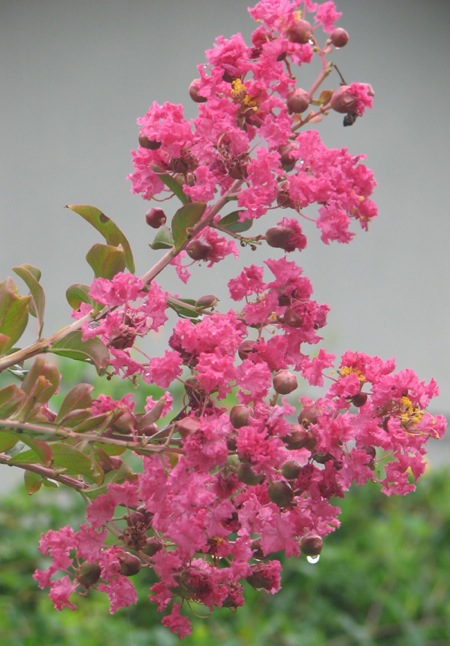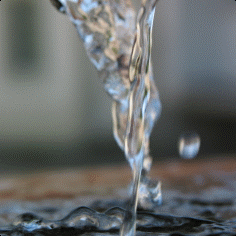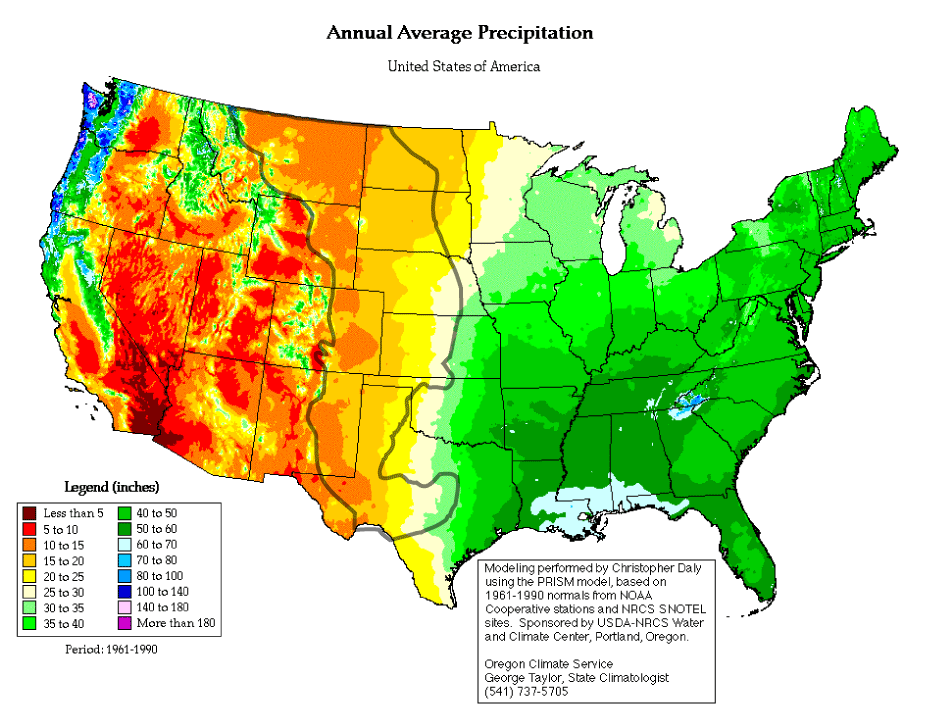


 |
Water | |
| Two Hydrogen atoms bond to one Oxygen atom comprising the water compound. |  |
|
| Water exists on earth in three conditions: |  |
|
| solid ( snow or ice ), liquid, and vapor gas. | ||

![]()
use | rivers | table | terminology | cycle | sources | terms | links | ecology of | related pages
![]()

The US / North America drought information and monitoring is: http://droughtmonitor.unl.edu/
Use:
The average American consumes 183 gallons of water per day to live, work, eat, keep clean, and travel.
We only need to drink about a gallon or two per day to survive.
The U.S. Geological Survey found that "California, Texas, and Florida accounted for one-fourth of all water withdrawals for 2000."
The United States, Russia, Canada, and Brazil possess within their borders, most of the planet's fresh water sources.
![]()
Water in the US is mostly used to cool electrical power plants, then to irrigate crops and next to provide 85 percent of the population with municipal water supplies.
In 2000, the USGS estimated that "408 billion gallons per day" of water was used, This is includes ground water and surface. There are significant trends toward an increase in groundwater use, since 1985 over surface water diversions.
The Survey goes on to say that "48 percent of all freshwater and saline-water withdrawals for 2000, were used for thermoelectric power," that is for generating electricity.
![]()
use | rivers | table | terminology | cycle | sources | terms | links | ecology of | related pages
![]()
Because of the way the survey explains water withdrawals, it is important to list what each sector reliably uses annually:
Sector |
Percentage |
Amount |
|---|---|---|
(thermal) electric power |
49.6 |
195 Bgal/d |
Irrigation |
34.6 |
137 Bgal/d |
Public-supply withdrawals |
10.8 |
43 Bgal/d |
Industrial |
5. |
20 Bgal/d |
total |
100 |
395 Bgal/d |
Bgal/d means billion (one thousand million) gallons per day.

use | rivers | table | terminology | cycle | sources | terms | links | ecology of | related pages
In addition the agency found that "Historically, more surface water than ground water has been used for irrigation. However, the percentage of total irrigation withdrawals from ground water has continued to increase, from 23 percent in 1950 to 42 percent in 2000." This means that ground water is becoming more important for both commercial and municipal use, despite the fact the all groundwater has its origins as surface water.
"California, Texas, New York, Florida, and Illinois accounted for 40 percent of total public-supply withdrawals and 38 percent of the total population served by public suppliers," according to the Geological Survey. In addition to this disproportionate use by the five largest states, the Survey reported in 2000 that "The largest surface-water withdrawals were in California and Texas, and the largest ground-water withdrawals were in California and Florida."
Surface water is actually the runoff, that does not percolate into the underground areas where wells retrieve it and we classify that subterranean source as ground water. The Survey goes on to say that "Total irrigation withdrawals were 2 percent more for 2000 than for 1995, because of a 16-percent increase in ground-water withdrawals and a small decrease in surface-water withdrawals."
source: United States Geological Survey: Circular 1268.

use | rivers | table | terminology | cycle | sources | terms | links | ecology of | related pages
A series of bends in the Kalahari desert of the Zambezi River above Victoria Falls.Rivers are just the most prominent feature created by the flow of surface water. Water in a desert is perhaps the single best metaphor that displays the precise relation of the earth's fluid endowment with respect to the other planets of the solar system -- none of which have liquid water on their surface of any measure, let alone the vast amount that covers the surface of the earth. Actually, instead or terra or earth, our planetary home should be oceanus or mare gigantum because marine water covers over seventy percent [70%] of the earth's surface, the remainder being land. Far from being a land planet we are a water planet where ice, vapor and liquid coexist and alter completely the conditions of existence on our third planet from the sun. Because of water persisting in three forms, the earth is unlike any other planet in the solar system.

use | rivers | table | terminology | cycle | sources | terms | links | ecology of | related pages
Source of life:
Only one tablespoon in every gallon of water on earth is fresh water (called potable water, the remaining water is salty, or frozen as ice.) Well over ninety-five percent [95%] of the water on earth is salt water, a solution of thirty three parts per thousand {or three point three percent [3.3%] solution} called marine water that forms the basis of our oceans, seas and larger saline lakes. Even though the hydrogen atoms and the oxygen atoms are dominant, the trace amounts of salt in solution make this water largely unavailable for humans and other fresh water dependent species to drink.

use | rivers | table | terminology | cycle | sources | terms | links | ecology of | related pages
The hydrological cycle
Due to the evaporation by the sun or volcanic activity, water is separated from the minerals and salts
associated with marine water and the water vapor condenses in the cooler atmosphere as fog or clouds. That process of evaporation and condensation is the source of rain, dew, fog, or snow that nourishes the fresh water ecological systems of the planet. Without water life becomes dormant and can cease altogether.
A stylized rendition of a watershed to reveal how the hydrological cycle adapts to the contours of the land and how the landscape is shaped by surface and underground movement of water falling upon the terrain.
Origins of the cycle as an indicator of natural balance.
water ethics | water centric | cycle | rivers | deserts | forests | worth of | Aquifers
Terms
hydrogen atom
hydroxyl radical
hydrogen bonds
ion
charged particle
hydrogen ions and acidification
- alkaline and pH range
- conductivity and convection
- emissive qualities and absorption
- reflectivity and albedo
- rivers
- River basins
- watershed
- preservation of wetlands
water ethics | water centric | cycle | rivers | deserts | forests | worth of | Israel & Palestine | Links
- Case studies of sources
- The Thames River, UK
- Columbia River flow and fisheries
- California water, history of
- Klamath River diversions
- Stanislaus River dam controversy
- Florida Everglades
- Amazon River
- Colorado River Dams and the Grand Canyon controversy
- reasonable use
- water engineering
- ethical restraint and water
- Adaptive Management of water and water basins
- Ecosystem services
Other pages about water on this site are . . .
Florida Defenders of the Environment
Tom's of Maine -- River's Awareness Program

use | rivers | table | terminology | cycle | sources | terms | links | ecology of | related pages
Last Updated on 03/01/2007. By Joseph Siry
schedule | Exchange | Atlas | site-index | Ecology | laws | quick look
Science Index | Site Analysis | Population Index | Global Warming Index | Nature Index | Research sites | Genes
Terms | Glossary | Word webs | Basic vocabulary | Advanced Vocabulary | Antonyms | Synonyms
Writing | Interviews | Free Writing
Start of this site | Site Map | Overview